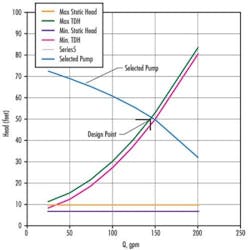Leading A Blooming Revolution
Algal blooms have caused issues for years, eventually leading to taste and odour problems if not treated properly. This year's Stockholm Water Prize winner, Steven Carpenter, has been pioneering studies, including research on trophic cascades, to help with the issue.
Tom Freyberg speaks exclusively to the professor to find out more.
March must have been a proud month for the United States. Libya intervention aside, the country received news that one of its leading academics had scooped the Stockholm Water Prize. Only a year earlier and another U.S. professor - Dr Rita Colwell - found out she had won the same prize for her research on the prevention of waterborne infectious diseases. Two out of two.
As expected from any prize laureate, Professor Carpenter's CV and list of publications and committees served is extensive. Too extensive to give justice in a few thousand words. Currently he serves as the professor of zoology and limnology at the University of Wisconsin-Madison, USA. One area he is best known for is research on trophic cascades in lakes - a concept which describes how impacts on any species in an ecosystem will cascade up, or down, the food chain (see illustration on page 14).
The theory, in layman's terms, says that overfishing of large fish can result in an increase of small fish, eventually decreasing the abundance of zooplankton further down the food chain. Without the latter consuming algal, it stands to reason to see how human activity - fishing large fish - has the knock on effect of increasing algal levels. It is the resulting increase in eutrophication that will be of specific interest to the water and wastewater industries. "If we are going to use trophic cascades to manage water quality, then we need to manage fishing as well," says Carpenter. So, in effect, human activity - through further fishing - can be seen actually increasing the issue of algal blooms in water?
"It depends on what people are fishing for, but that is correct," he says. "If there is heavy fishing on the forth trophic level - big fish eating fish - that is generally going to either increase algal or make the lake more vulnerable nutrient input."
Of course the topic of Harmful Algal Blooms, otherwise known as HABs, is a topic being taken seriously worldwide. These blooms can cause harm through the production of toxins or accumulated biomass. Substantial economic losses to coastal communities and potential human illness and mortality are just some of the possible effects. To discuss these issues further, Water & Wastewater International (WWi) caught up with Professor Steven Carpenter (SP) to find out more.
WWi: How big a problem are algal blooms and eutrophication when it comes to water supply?
SH: They are a very large problem worldwide. The drivers vary from country to country but farming is one of the principal drivers. Excess nutrients; nutrients from manure and erosion driven by farming practises are major
factors in poor water quality and many waters of the upper great lakes region [U.S.] suffer from this problem. Parts of Europe suffer from the same issues. Although regulations are different and farming practises differ from nation to nation, many of the heavy agricultural regions of Europe have much the same issues as the heavily agricultural regions in the U.S.
China has enormous problems with algal blooms - some of the worst water quality problems in the world occur in China. Farming is part of the problem here - farming of manure and also human waste and incomplete treatment of sewage or non-treatment of non-sewage is also a huge factor. Aside from freshwater, the number and extent of harmful algal blooms in coastal oceans is on the rise globally.
Those blooms are driven by nitrogen phosphorous, delivered by the river systems to the coastal oceans. It's a substantial problem globally. But in each region the particular details of the drivers are idiosyncratic and need to be worked out.
WWi: Another big topic currently discussed is the health risk with harmful algal blooms surviving standard purification treatments and associated water supplies. Thoughts?
SH: There's a great deal of concern about that in the United States right now - the technology for detecting harmful toxins has been improving: the more we look the more we find. Microcystins - extremely deadly liver toxins - as well as some neurotoxins are showing up in surface waters much more commonly than we thought. We are finding this out simply because we can measure them now.
So there are organic chemistry techniques for measuring at low concentrations and also the genomics - the genetic analysis of the bio bacteria. So we are learning more about the particular genetic structures that are involved in making the toxins, and more about the induction of the toxins. Of course there is still a great deal to be learned but in my region: blooms are looking much more dangerous than we thought.
WWi: In the prize statement, it said that your research findings have "influenced concrete strategies for dealing with eutrophication and have provided a practical framework for the management of freshwater resources". You have also managed to link research to both policy and practice. Can you provide examples of how your research and developments have led to these concrete strategies?
SH: I've done a great deal of work on irreversible eutrophication. There are a number of cases where shipping points are passed and recovery from eutrophication takes longer than you think it would.
Furthermore, in those cases the economics gets very interesting because the cost of poor water quality has to be born into the future, longer than one might expect as a priority.
WWi: You mentioned in your work changing farming practises. Do you think there needs to be more education on how such activity is impacting on water supplies further down the chain?
SH: Certainly more education will help. In fact I think that we need to dramatically rethink agriculture. We're heading for a world with nine billion people by about 2050 - nine billion is about the most optimistic. We're not doing a very good job at feeding the seven billion population we have now. By various estimates, there are about one billion people going hungry. I see big problems going forward by providing enough food for earth's people while maintaining fresh water, which is just as important as food for life.
Agriculture is currently the biggest user of terrestrial land, the biggest consumer of freshwater and the biggest polluter of water and among human activities. Not to mention it's the largest driver of climate change. And we need to increase its intensity.
WWi: Phosphorous is often cited as one of the main culprits when it comes to eutrophication - in lakes subjected to pollution from sewage pipes. The end of last year saw Europe's first phosphorous recycling facility open in London, removing struvite, a compound containing phosphorous and ammonia from sewage to be turned into premium-grade, slow-release fertiliser. Do you think such technology and processes should be more commonly used?
SH: With phosphorous we're at an interesting time in earth's history. We're realising it's quite an important pollutant that is causing enormous damage particularly and intensively to agricultural regions. At the same time, there's evidence that we're running out of it.
There have been some recent projections that phosphorous reserves will be exhausted in as little as 20 years' time. There is a fair amount of controversy around those projects and a fair amount of uncertainty, but nonetheless the known reserves of phosphorous are finite and seem to be limited.
Also, phosphorous is controlled by a small number of countries - the U.S., China, Morocco, South Africa. In essence, they could function like a phosphorous cartel like OPEC [Organisation of the Petroleum Exporting Countries] functions like for petroleum. There could be some very interesting price dynamics if that happens.
For example, if the price of phosphorous starts to go up due to limited production, these sort of recycling and conservation measures for phosphorous will be a lot more attractive economically. And that could have big benefits for freshwater quality.
WWi: In your prize winning video interview, you mentioned the need for more science to understand catastrophic events, such as the recent magnitude 9 earthquake in Japan. Can you talk about this further?
SH: I think we need at least three things. First of all, we need better technical understanding from the natural science side of how catastrophic event risk is changing in a highly connected world. The human population is continuing to grow - our economies, our information systems, our movement of goods and services - are more connected than ever. That creates new vulnerabilities to things like diseases, or the knock-on economic consequences of catastrophes like the recent earthquake. These challenges are changing in ways that natural scientists need to home in on a little bit more. I'm quite confident this research can be done.
Secondly, we need to work on effective human cognition, with respect to low probability, high impact events. Humans are intrinsically not good at handling those events intuitively. Our intuition is much better honed to the routine-type events.
We're fine with randomness, but not good with low probably, high-impact. That is simply of matter of teaching and can probably be done in the school with simple games to help students build understanding catastrophic risk.
The third thing is we need institutions that build resilience to these risks. Our institutions, for the most part, are built around dealing with routine risk, which has fairly minor consequences. We handle catastrophes in a completely reactive way - we just mop up after they happen. But in fact there are ways of designing landscapes and seascapes so that they are more resilient to catastrophes.
And designing social networks and the way people interact and the way assurance is provided at various levels by human interaction. There are ways of designing institutions that are better able to bounce back when catastrophe hits. I believe it's an interdisciplinary science challenge, involving institutions, human psychology, teaching and natural science research.
WWi: What can we expect to see from you next? What projects and areas will you be concentrating on?
SH: I have a project which is working on developing early warning systems for catastrophic change in environmental systems. Right now with colleagues I'm conducting some very large scale experiments where we are gradually inducing catastrophic change in food webs and attempting to see if we can detect these indicators before the catastrophe occurs. So these are large scale tests of early warning indicators. This is a field which is mostly in its infancy, and has been mostly mathematical and theoretical so far. The next stage is to take it into the field and make it real. That is what we're going to be doing over the next few years.
More Water & WasteWater International Current Issue Articles
More Water & WasteWater International Archives Issue Articles




